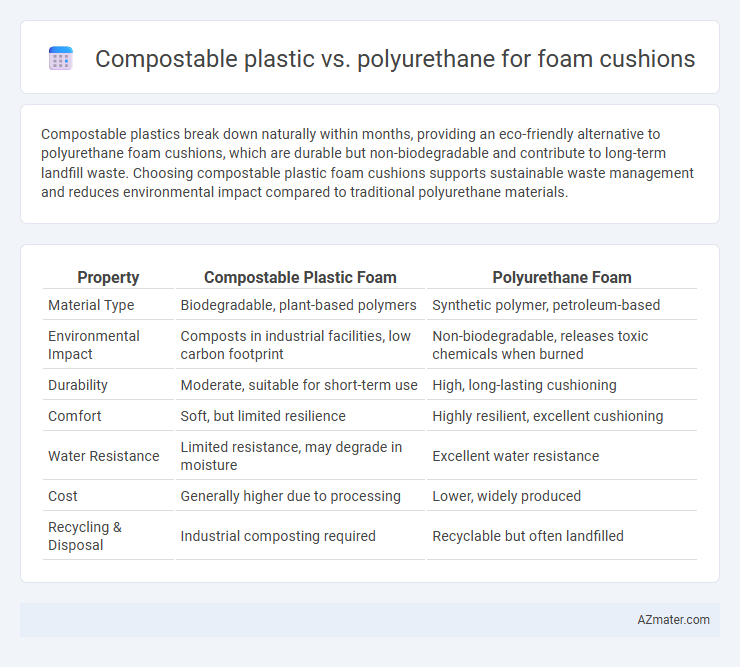Compostable plastics break down naturally within months, providing an eco-friendly alternative to polyurethane foam cushions, which are durable but non-biodegradable and contribute to long-term landfill waste. Choosing compostable plastic foam cushions supports sustainable waste management and reduces environmental impact compared to traditional polyurethane materials.
Table of Comparison
| Property | Compostable Plastic Foam | Polyurethane Foam |
|---|---|---|
| Material Type | Biodegradable, plant-based polymers | Synthetic polymer, petroleum-based |
| Environmental Impact | Composts in industrial facilities, low carbon footprint | Non-biodegradable, releases toxic chemicals when burned |
| Durability | Moderate, suitable for short-term use | High, long-lasting cushioning |
| Comfort | Soft, but limited resilience | Highly resilient, excellent cushioning |
| Water Resistance | Limited resistance, may degrade in moisture | Excellent water resistance |
| Cost | Generally higher due to processing | Lower, widely produced |
| Recycling & Disposal | Industrial composting required | Recyclable but often landfilled |
Introduction to Sustainable Foam Cushion Materials
Compostable plastics offer an eco-friendly alternative to traditional polyurethane foam cushions by breaking down naturally in composting environments, reducing landfill waste. Polyurethane foam, widely used for its durability and comfort, presents challenges in sustainability due to its petroleum-based composition and limited biodegradability. Innovations in sustainable foam cushioning focus on integrating compostable polymers to create materials that maintain performance while minimizing environmental impact.
Overview of Compostable Plastic in Cushion Production
Compostable plastic in cushion production offers an eco-friendly alternative to traditional polyurethane foam by using biodegradable materials derived from renewable resources such as cornstarch or sugarcane. These compostable plastics break down naturally under composting conditions, reducing landfill waste and minimizing environmental impact. Although compostable foam cushions typically have lower durability and resilience compared to polyurethane, ongoing advancements in biopolymer technology are enhancing their performance and market viability in sustainable furniture manufacturing.
Understanding Polyurethane Foam: Composition and Uses
Polyurethane foam is a versatile polymer composed of organic units linked by urethane bonds, widely used for cushioning due to its durability, flexibility, and resistance to wear. It serves in various applications including furniture, automotive seating, and bedding, offering superior comfort and support compared to compostable plastics, which degrade faster but lack the same resilience. Its synthetic composition allows for customization in density and firmness, making polyurethane foam a preferred choice in high-performance cushioning products.
Environmental Impact: Compostable Plastic vs. Polyurethane
Compostable plastic foam cushions significantly reduce environmental impact by breaking down naturally within months in industrial composting facilities, minimizing landfill waste and lowering greenhouse gas emissions compared to polyurethane, which can take centuries to decompose and often releases toxic chemicals. Polyurethane foam production relies heavily on petroleum-based resources, contributing to fossil fuel depletion and higher carbon footprints, while compostable alternatives utilize bio-based materials with smaller ecological footprints. Waste management challenges for polyurethane include non-biodegradability and limited recycling options, whereas compostable plastics offer improved end-of-life solutions that support circular economy practices.
Biodegradability and End-of-Life Considerations
Compostable plastic foam cushions degrade naturally within industrial composting environments, breaking down into non-toxic organic matter typically within 90 to 180 days, significantly reducing landfill waste and environmental impact. Polyurethane foam cushions exhibit low biodegradability, often persisting in landfills for over 500 years due to their complex polymer structure, posing considerable end-of-life disposal challenges. Selecting compostable plastics supports circular economy goals by enabling composting or anaerobic digestion, whereas polyurethane requires energy-intensive recycling or incineration, emphasizing the need for sustainable material innovation in cushioning applications.
Performance and Comfort Comparison
Compostable plastic foam cushions typically offer biodegradability and environmental benefits but may lack the durability and resilience found in polyurethane foam. Polyurethane foam cushions excel in providing superior comfort through enhanced support, pressure distribution, and long-term durability, making them ideal for high-use applications. Performance-wise, polyurethane maintains structural integrity and cushioning effect over prolonged use, whereas compostable foams may degrade more quickly under stress, impacting comfort and lifespan.
Manufacturing Processes and Resource Consumption
Compostable plastics for foam cushions are typically derived from renewable resources like cornstarch or sugarcane, utilizing biopolymer extrusion and mold foaming processes that consume less fossil fuel energy but may require more agricultural inputs. Polyurethane foam manufacturing involves chemical reactions between polyols and isocyanates, relying heavily on petrochemical feedstocks and energy-intensive processes, resulting in higher carbon emissions and resource usage. The biodegradable nature of compostable plastics offers advantages in end-of-life management, while polyurethane's durability and manufacturing scalability continue to dominate cushion production despite greater environmental resource demands.
Cost Analysis of Compostable Plastic and Polyurethane Foams
Compostable plastic foams generally present higher upfront material costs compared to polyurethane foams due to specialized biodegradable resin production and limited large-scale manufacturing. Polyurethane foams benefit from economies of scale and established supply chains, resulting in lower per-unit costs that make them economical for mass foam cushion applications. However, when factoring in environmental compliance, disposal fees, and potential recycling savings, compostable plastic foams may offer long-term cost advantages despite initial expenses.
Market Trends and Innovations in Cushion Materials
The foam cushion market is witnessing a significant shift towards sustainable materials, with compostable plastics gaining traction due to their eco-friendly biodegradability compared to conventional polyurethane foams. Innovations in bio-based polymers and advanced compostable composites are enhancing durability and comfort, challenging polyurethane's dominance in cushioning applications. Market trends indicate growing consumer demand and stricter environmental regulations are accelerating the adoption of compostable foam cushions in furniture and automotive industries.
Future Prospects and Recommendations for Eco-Friendly Foam Cushions
Compostable plastic foam cushions offer promising future prospects due to their biodegradability and reduced environmental impact compared to traditional polyurethane foams, which rely on petroleum-based chemicals and persist in landfills for decades. Advancements in bio-based polymers and microbial degradation technologies are accelerating the commercial viability of compostable foam alternatives, making them a strategic choice for sustainable product design. Industry leaders and manufacturers should prioritize research and investment in compostable materials, leveraging certifications like ASTM D6400 or EN 13432 to ensure eco-friendly performance while educating consumers about responsible disposal to maximize environmental benefits.

Infographic: Compostable plastic vs Polyurethane for Foam cushion
 azmater.com
azmater.com